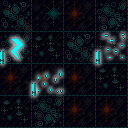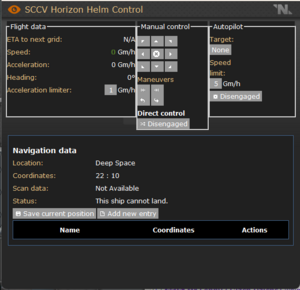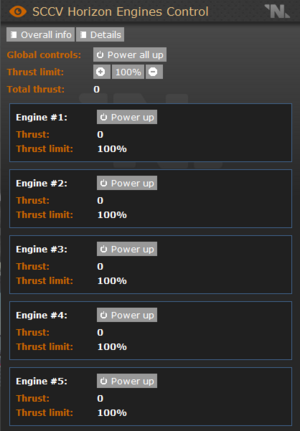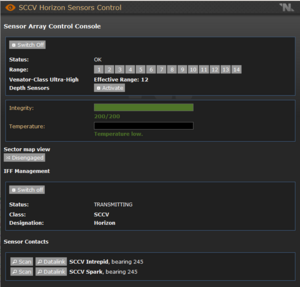Guide to Piloting
Who can fly what?
Before reading through this guide, it can be useful to know who can fly what aboard the Horizon. This is the list of various spacecraft available to the crew, including the Horizon itself, and who can fly each.
- Spark - Miners, Xenoarcheologists, Bridge Crew, Operations Manager, Research Director, Executive Officer, Captain
- Intrepid - Xenoarcheologists, Bridge Crew, Operations Manager, Research Director, Executive Officer, Captain
- Horizon - Bridge Crew, Executive Officer, Captain
The rest of command can fly the Intrepid and Spark on a case by case basis, where the character's background should have a justifiable reason for it.
While some roles may have the knowledge and ability to fly a certain spacecraft, it is best practice to leave the flying to the dedicated pilot of that craft. For instance, the Intrepid should be piloted by Bridge Crewmen and Xenoarcheologists if possible. The Spark should be piloted by Miners.
Overmap

The overmap is functionally a z-level portraying the sector of space surrounding the ship. Every round, the ship begins on a random part of a randomized overmap, and by flying the ship across the overmap, you'll encounter various events and objects on it.
Some of the events you can expect to encounter are:
- Dust clouds: Clouds of high-speed dust that can collide into your windows and hull, wearing it down.
- Asteroid fields: Belts of meteors that have a tendency to slam into your ship, destroying hull around the site of impact. Even worse, some meteors can have EMP effects on impact, discharging your electrical equipment.
- Ion storms: Passing through these will scramble the laws of any bound synthetic, or an AI.
- Electrical storms: These will discharge and automatically turn off any electrical equipment (including APCs or an SMES) on the ship. Naturally, without electricity, your ship can't be controlled and will begin to drift.
- Carp shoals: Huge swarms of ferocious space-faring carnivores, eager to break through your windows to get a taste of sweet sapient flesh.
- Dark matter: Passing through these briefly scrambles ship gravity, leaving you to float aimlessly if you're not buckled to a chair or railing.
- Points of interest: Anything from planets, drifting derelicts, stations, sensor relays, and even other ships. Exploration is one of the goals of the Horizon, after all, and most ships are generally neutral to your presence in the sector... generally.
Piloting A Ship

Piloting is deceptively simple; open up a helm console, press a directional key, and the ship will begin to move in that direction. Press X to slow down the ship or stop it. Several factors, however, complicate this.
Important: Newton's first law dictates that an object in motion stays in motion, unless acted on by external forces. Air resistance and friction don't exist in the vacuum of space, so a ship is going to keep going in the direction you pushed it in originally unless you perform a reverse-burn by pressing X to stop it.
TL;DR: if you make the ship go left, it will keep drifting left until you press the center X to stop it. It doesn't slow down on its own.
For a ship to even begin to move, it needs to have thrust. What this means is that the thrusters, those funny little nozzles at the back of a ship, must be a) powered on and b) have fuel inside of them. The Horizon has thrusters that use a mixture of phoron and oxygen to propel the ship, and it is the job of the Atmospheric Technicians to prepare the thrusters at the start of the round. Every other ship, like the Spark and Intrepid, will use CO2 to propel themselves.
To power on the thrusters, you'll need to open up the engine control console. Then, you can use the global controls to power up all the engines. Success! Now your ship has thrust! You can also control the amount of thrust the nozzles are receiving by editing the thrust limiter at the top of the window; this is useful if you want to save fuel.

A Quick Helm Console Overview
To make a ship move faster, it's recommended you edit the acceleration limiter under the flight data heading; a nice number to start with is 5. Unless your atmos techs are really cooking with gas, the Horizon isn't going to move faster than about three (3) gigameters per hour (Gm/h). Smaller shuttles, like the Intrepid and Spark, can move along way faster.
ETA to next grid is, as of 4/25/2023, finicky after an update to the speed of the thrusters. The best way to determine how far you are from the next grid is to see where your ship icon on the overmap is positioned in relation to the grid of the sectors.
Your speed will tell you just how fast your ship is going. If the speed is highlighted in green, that means you can move safely through hazards like asteroids, space dust, and carp shoals (for experienced pilots only!).
Your bearing tells you the degree of the direction in which you're going, a la nautical navigation. You can easily navigate to a point of interest if you have its bearing, which should be on the sensor readout printed at every command console at the start of the round.
If you want to register where you found a point of interest, you can Save Current Position or Add New Entry to keep the data on your helm console for easy navigating back.
Autopilot
DO NOT USE AUTOPILOT.
Yes, really. If autopilot is activated, it will do exactly what it says; pilot the ship on its own. The problem is is that it will take you to the programmed destination through every hazard in the way. Autopilot will also constantly be correcting its speed to stay on-target by burning forward, reverse-burning, and then burning more, which will use up a ton of fuel and thrust.
Once again; DO NOT USE AUTOPILOT.
Sensors
To detect hazards and points of interest, all ships are equipped with a complex sensor array that shows the area in a varying range around the ship. In order to properly navigate the sector, it is first recommend you switch on the sensors.

Next, set the sensor range to something median. 4 is usually recommended because it won't actively increase the temperatures of the sensor array, and allows you to get a good look at what's around you. The sensors will begin to gradually increase their range, as indicated by which number is highlighted in green on the UI. Also available on some ships is the ultra-high class depth sensors, which will let you see through the hazards around you at the cost of heating up the sensors much quicker.
If your sensors heat up too much, indicated by the temperature gauge, they'll begin to take damage. If your sensors are destroyed, this means you're left blind in the middle of space, and an engineer will have to fix the array. Don't let your sensors heat up too much!
Once the sensors are online, they will begin to ping their surroundings, opening up a view of the map to you. When the sensors detect a point of interest, like a planet or another vessel, your chat will alert you that a "Bogey" has been detected, and give you a rough estimate of its bearing. While you remain in sensor range of the point of interest, your sensors will scan the "Bogey", and eventually identify to you what it is.
Shuttle Maintenance
Some shuttles are slightly different from their original implementation in that they can dock and depart from the main map and fly around the overmap independently. As far as the overmap is concerned they function exactly the same, requiring gas (usually carbon dioxide in canisters as it's one of the more efficient options available, but you can use any gas you like) to be supplied to the thrusters in order to move. However, shuttles also use a secondary fuel that allows them to dock and depart from wherever they are, namely phoron (although in a pinch hydrogen could still work here too) inside tanks placed inside an orange fuel port somewhere on the shuttle. Replacing the fuel tank is as simple as opening the hatch with a crowbar, yanking the old tank out with an open hand, and clicking the port with the new tank to slot it in, then shutting it closed with a crowbar to finish it up.
Lastly, it's important to remember that shuttles do not have an infinite supply of power (If they do, that's temporary, this is all new after all!): the SMES and APCs will gradually drain while undocked, with a varying rate depending on how much equipment is turned on. This is usually not a huge concern, as shuttles tend to come with a large supply of power to last the entire round. It will mainly become an issue if you end up hitting an overmap hazard that affects your SMES, which usually means all power was drained or that the machine itself was totally destroyed. Sometimes, it might even be sabotaged if there's antagonists about. Luckily, you may have a generator on hand that can be fed with fuel (usually phoron or uranium sheets depending on the type) so that you're not totally stuck. It would be best to use the time it buys to phone home via your holopad if possible and either sit tight or head there yourself.
New Away Sites
The primary purpose of the SCCV Horizon is to travel the spur in search of more Phoron deposits, as those in the Romanivich Cloud have dried up. Because you can't mine space, or look for artifacts in the void, miners and others will need to go to away sites in search of deposits to mine and claim for the SCC. The Horizon has two shuttles to accommodate this. One is a mining shuttle, very small and primarily used by miners to get to where they need to mine with all their equipment, and then the Intrepid a larger shuttle is used for crew away missions, which are primarily based around surveying and exploration. However, this doesn't mean a xeno-archeologist cannot go with the miners in their shuttle, and the miners can't go aboard the Intrepid, after all, if you're both headed to the same place, why waste the fuel?
How to get to the Away Site
As stated the only way to get away sites is to fly there, in one of the two shuttles. Shuttles can be flown independently by Prospectors, who have the required training, but with larger crew away missions it is advisable to take a more dedicated pilot, such as one of the Bridge Crew along to fly. As for the exact way to get there, it can either be done by parking the Horizon above the target asteroid or planet, and then taking the shuttle down much like how the current research shuttle works; or the shuttle can get the coordinates from the bridge and fly across the overmap to their target instead, without the main ship having to move. The most expedient way to go about this is having the faster Intrepid or mining pod head to their desired destination while the slower Horizon follows them.Command staff should not accompany expeditions to away sites unless they are necessary for it's success, instead a Bridge Crewman should be chosen and ordered to accompany the expedition in lieu of actual command staff.
Asteroids
Due to the training taking place within the Romanivich Cloud, a majority of the new away sites will be asteroids, full of what was previously found on the NSS Aurora asteroid. So they will contain minerals, xeno-archology artifacts, as well as other new ruins, but may have hostile lifeforms such as dwellers and carp on them, or even people in ghost roles. It is important to remember that these asteroids will be much safer then places the Horizon may visit in the future, and are a good training ground for learning how to do away missions off of a ship.
Derelicts
Remains of ships and stations that have long been decommissioned, Derelicts are the other away site you may run into during testing within the Romanivich Cloud. Holding anything from old corporate equipment to experiments gone wrong, nearly anything can be found. While these will not have the mineral wealth of asteroids, they may contain unknown artifacts or other interesting scraps for the crew to uncover.
Emergency! We've Been Hit By Meteors!
The most important aspects for the survival of a ship consists of three things. Navigation to direct the ship, thrusters to move and power to keep both operational. If you lack one of these, you need to fix that and it should have the priority because as long as they're active, your vessel could still remain operational and capable of moving to safety despite being full of holes or having entire segments obliterated. On the Horizon it's likely you'll have a capable engineering team at your back ready to clean up any messes and maintaining the bigger systems that are beyond you like the engine, so you'll be more focused on moving to safety.
If you're flying a smaller shuttle it's still important to remember you're still reliant on navigation, thrusters and power and now you're empowered to do more about it if there's an issue. if you went into a meteor field, some meteor types could end up temporarily depowering an APC (or totally drain it) in your cockpit and now you're out of control. That might be the end for you and your crew, but it doesn't always have to be. Designated pilots for a shuttle usually have access to the APCs inside, so swiping your ID and pressing the reboot button might be all you need to do to regain control. If it's totally depowered, you can either anxiously wait for it to recharge or replace the battery quickly after disabling the cover lock and crowbarring the machine open.
In the middle of all this it could be a good idea to have someone calling home if that's an option since your life would be made much easier by the Horizon moving closer or teleporting aid and additional personnel over. Just make sure they have a ship they can actually save, and that any would be rescuers aren't teleporting onto a death trap.